For scientific photography, you’ll find ImageJ and its Fiji distribution extremely versatile, supporting over 130 file formats including DICOM and microscopy data. Huygens Software handles proprietary formats with its Full File Reader, while QuPath manages large pyramidal bioimages efficiently. OsiriX and 3D Slicer excel specifically with medical imaging files. These programs preserve essential metadata during analysis and conversion, maintaining your research integrity. The sections below detail specialized applications for every scientific imaging need.
What Image Software Opens Scientific Photography File Types?

When exploring the world of scientific imaging, you’ll quickly discover that specialized file formats require equally specialized software. ImageJ stands out as a versatile solution, supporting over 130 file formats essential for scientific photography, including microscopy and medical imaging files.
Scientific imaging demands specialized tools — ImageJ excels by supporting 130+ formats for microscopy and medical visualization.
For medical researchers, ImageJ’s built-in support for DICOM files is invaluable, with additional plugins enhancing functionality. The Fiji distribution of ImageJ includes OME Bio-Formats plugins, allowing you to open various scientific formats while preserving vital metadata.
When working with proprietary microscope data, Huygens software offers compatibility with major vendor file formats and versatile saving options like ICS, OME-Tiff, and HDF5.
For large bioimages, consider QuPath, which efficiently handles pyramidal images for optimal analysis performance.
Popular Software for Handling Raw Microscopy Data
Beyond basic file opening capabilities, scientific researchers need robust tools designed specifically for manipulating complex microscopy data. ImageJ stands out with support for over 130 image file formats through its OME Bio-Formats plugins, making it ideal regardless of your quality setting preferences.
For proprietary formats from major microscope vendors, Huygens Software’s Full File Reader guarantees you’ll rarely encounter a different file type you can’t analyze. QuPath excels with pyramidal images, while OME-TIFF format provides standardized metadata storage critical for preserving acquisition parameters.
Fiji, an ImageJ distribution, adds extended functionality for microscopy workflows, while HDF5 plugins enable efficient handling of large datasets.
These specialized tools guarantee you can process raw microscopy data with precision across various experimental contexts.
Multi-Dimensional Image Support in Scientific Imaging Tools
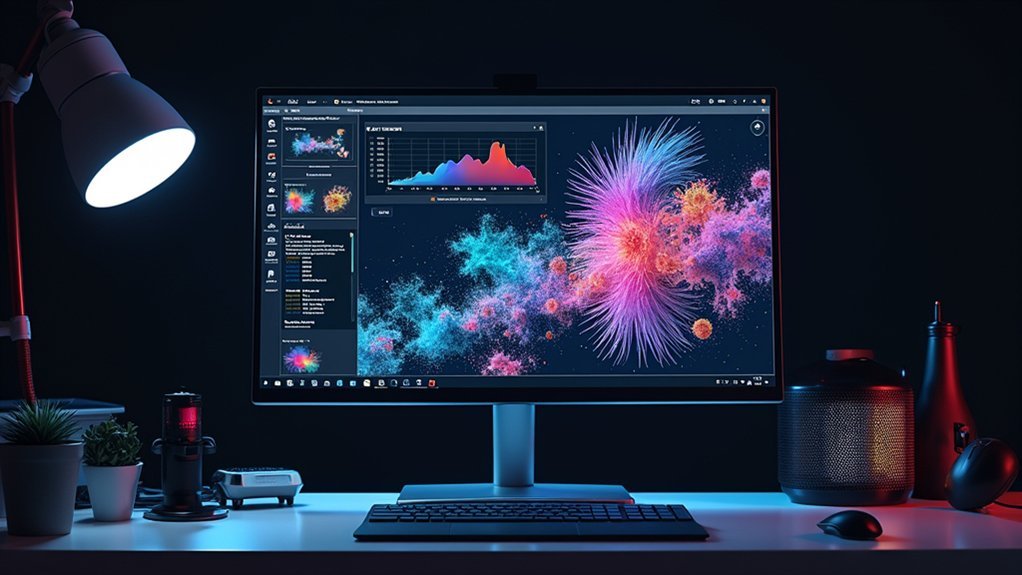
Modern scientific imaging frequently generates complex datasets that extend beyond simple 2D representations. When working with multi-dimensional image support, you’ll need software capable of handling time, depth, and spectral channels simultaneously.
ImageJ with its Bio-Formats plugin gives you access to over 130 file formats while maintaining important metadata across dimensions. Similarly, Huygens Full File Reader directly opens proprietary formats from major microscope manufacturers, automatically importing essential parameters for accurate analysis.
For storing your complex datasets, consider formats like OME-TIFF or HDF5, which preserve metadata while enabling efficient management of large files.
These formats guarantee compatibility across different analysis platforms, allowing you to seamlessly shift between visualization, processing, and quantification of your multi-dimensional scientific images without losing valuable information.
Specialized Applications for DICOM Medical Image Files
Although standard image software can open basic DICOM files, specialized applications offer considerably more powerful capabilities for medical professionals.
ImageJ provides built-in DICOM support that lets you analyze medical images without additional plugins, though enhanced functionality is available through various extensions.
When working with DICOM files, you’ll need to verify compatibility with your specific file variations, as support can differ between platforms.
For more advanced medical imaging needs, purpose-built applications like OsiriX and 3D Slicer deliver tailored features that general image software lacks.
These specialized tools help you navigate the complexity of medical imaging data, preserving essential patient information and imaging parameters while providing analytical capabilities designed specifically for healthcare and research environments.
HDF5 File Format Readers and Processing Software
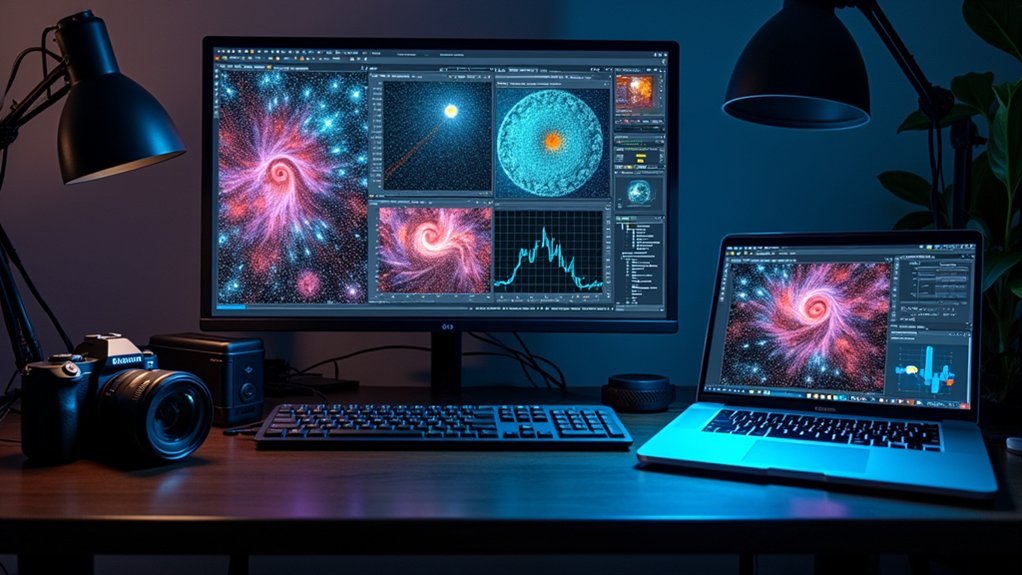
The HDF5 file format serves as a powerful alternative to DICOM in scientific imaging applications where handling large, complex datasets becomes necessary. You’ll find this hierarchical format particularly useful when working with multi-dimensional image data that requires efficient storage and access.
| Software | HDF5 Capabilities |
|---|---|
| ImageJ | Built-in support for reading/writing HDF5 files |
| Fiji | Enhanced plugins for complex HDF5 structures |
| Huygens | Professional-grade HDF5 processing tools |
| Custom Python | Flexible scripting for batch processing |
When implementing HDF5 in your workflow, verify your software is compatible with specific HDF5 constraints to prevent data interpretation issues. The format’s support for parallel I/O operations makes it ideal for processing extensive datasets, greatly improving performance in your scientific research applications.
Tools for Analyzing OME-TIFF Images in Research
Three key advantages make OME-TIFF a cornerstone format for scientific image analysis in research environments.
First, it preserves both pixel data and extensive metadata, ensuring your analytical workflow retains critical experimental context.
Preserving both pixels and metadata in OME-TIFF maintains essential experimental context throughout your analytical process.
Second, it supports multi-dimensional datasets, letting you work with complex time-lapse and multi-channel microscopy image files.
Third, it enhances cross-platform compatibility, maintaining data integrity between different software systems.
To analyze OME-TIFF files, you’ll find ImageJ and its distribution Fiji particularly effective, especially when equipped with the Bio-Formats plugin.
This combination provides a user-friendly interface for importing, visualizing, and processing these specialized files.
Additional tools like Huygens offer advanced analysis capabilities, creating a robust ecosystem that supports reproducible scientific imaging research across disciplines.
Video Format Compatibility for Time-Lapse Microscopy
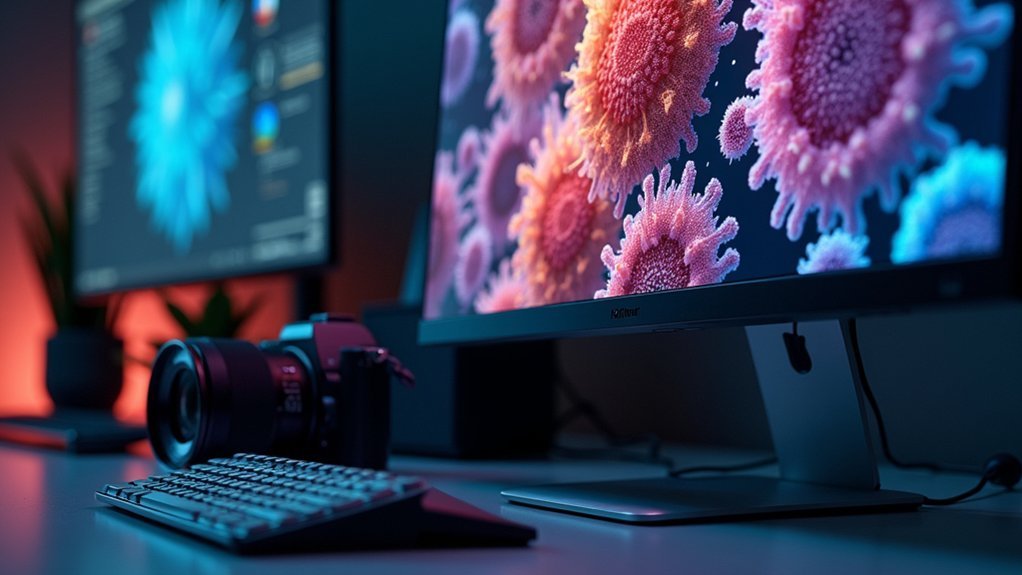
When conducting time-lapse microscopy experiments, you’ll need to contemplate which video formats will best preserve your scientific data.
ImageJ offers native support for AVI and QuickTime formats, which you can extend through additional plugins for more specialized time-lapse microscopy applications.
For ideal quality, consider exporting uncompressed AVI files directly from ImageJ. This approach prevents data degradation that often occurs with lossy compression methods like JPEG, which can introduce artifacts and compromise your research integrity.
You can adjust frame rates between 0.1 and 100 frames per second, giving you flexibility in visualizing temporal processes.
When working with formats beyond ImageJ’s built-in capabilities, specialized plugins are available to handle various video formats, streamlining your workflow from acquisition to analysis.
Metadata Preservation Across Different Software Platforms
While mastering video formats guarantees proper visualization of your time-lapse data, preserving metadata between software platforms remains equally important for scientific integrity.
When transferring files between applications, you’ll need to select formats that maintain critical imaging parameters.
For scientific imaging, prioritize OME-TIFF as the gold standard for metadata preservation across platforms. ImageJ’s default uncompressed TIFF output reliably stores multiple bit depths and essential metadata.
Avoid general-purpose formats like JPEG, which compromise both pixel values and metadata through lossy compression.
Scientific software like Huygens supports specialized formats including ICS, OME-TIFF, and HDF5 to safeguard your data’s integrity.
Always verify that reopened images retain all original dimensions and values—missing metadata can invalidate your research measurements and compromise reproducibility.
Open-Source Solutions for Scientific Image Processing
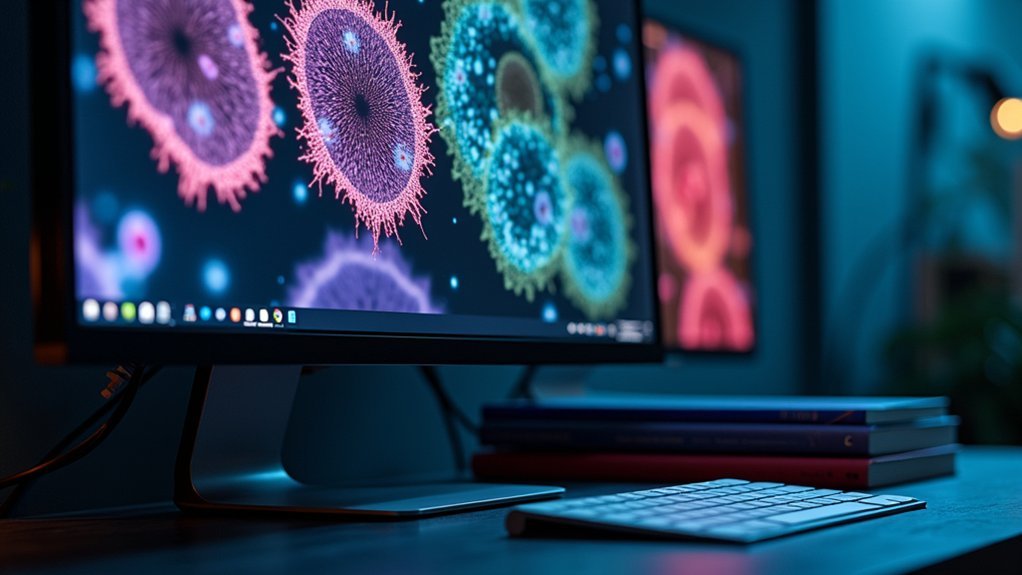
Although commercial software offers polished interfaces, open-source alternatives provide remarkable flexibility without the hefty price tag. You’ll find Fiji and ImageJ particularly valuable, supporting over 130 file types including DICOM files, without compromising on compression algorithm compatibility.
| Software | Specialty | Supported Formats |
|---|---|---|
| Fiji | Microscopy | 130+ scientific formats |
| ImageJ | Analysis | DICOM, TIFF, RAW |
| Huygens | Conversion | Proprietary microscope files |
| QuPath | Bioimage | Pyramidal formats |
| GIMP | Editing | Extendable via plugins |
These open-source solutions enable you to access, analyze, and convert scientific images while preserving critical metadata. QuPath excels with large bioimages, while Huygens facilitates batch processing. Even GIMP can be customized for scientific work through specialized plugins.
Converting Between File Formats While Maintaining Data Integrity
When you’re converting scientific images between formats, you’ll need to employ lossless conversion methods that preserve all original pixel values and relationships.
You can maintain data integrity by using tools that properly transfer metadata, such as header information, calibration data, and acquisition parameters, which are essential for reproducibility and analysis.
Setting up automated batch processing workflows with validation checks will save you time while ensuring consistent quality across large datasets, particularly when converting multiple files from proprietary formats to open standards like OME-TIFF.
Lossless Conversion Methods
Converting between image formats becomes critical in scientific workflows because preserving every bit of original data directly impacts research validity.
You’ll want to prioritize lossless compression techniques that maintain the complete integrity of your original image during format changes.
TIFF and OME-TIFF stand out as preferred formats in scientific imaging because they preserve high bit depth and detailed metadata critical for analysis.
When converting files, select specialized scientific software like ImageJ or Huygens that’s designed specifically for research-grade conversions.
Even with large datasets, you don’t need to sacrifice quality for storage efficiency.
Modern lossless algorithms compress files while maintaining complete data fidelity.
Always verify your conversions by comparing pixel values and metadata between original and converted files to confirm nothing essential has been lost during the process.
Metadata Preservation Techniques
Successful metadata preservation requires more than just maintaining pixel values during format conversion. When you’re working with scientific images, choose software specifically designed for this purpose, like ImageJ or Huygens, to guarantee critical metadata remains intact.
OME-TIFF stands out as the preferred format for standardized metadata storage, preserving essential information that JPEG or PNG would sacrifice. For ideal quality and compatibility, save your files in the default format of your scientific software—typically TIFF in ImageJ.
For larger datasets, consider HDF5, which efficiently stores information while maintaining metadata integrity, though support varies across platforms.
Always verify your chosen format can be reopened with complete metadata intact. Improper conversions risk compromising not just file quality but the scientific validity of your measurements.
Batch Processing Workflows
Scientific workflows involving multiple images require efficient processing methods that preserve data integrity across format conversions.
When you’re handling numerous scientific images, batch processing workflows become essential for maintaining consistency and accuracy.
You can efficiently convert proprietary microscope formats like LASAF or Nikon ND2 to standardized formats such as OME-TIFF or HDF5 using tools like the Huygens Workflow Processor.
These tools guarantee your files aren’t compressed using lossy methods that might compromise critical data.
Always verify that your converted files maintain the original bit-depth and image dimensions.
OME-TIFF is particularly valuable due to its standardized metadata storage capabilities, making your files compatible across different analysis platforms.
Before proceeding with analysis, check that all pixel values and metadata remain intact throughout the conversion process.
Frequently Asked Questions
What Formats Can Imagej Open?
ImageJ can open TIFF, DICOM, HDF5, AVI, QuickTime, and over 130 scientific formats through the OME Bio-Formats plugin. You’ll find it handles most microscopy formats and medical imaging files effectively.
What’s the Difference Between HEIF and JPEG?
HEIF offers 10-bit color depth (4x more than JPEG’s 8-bit), better compression for smaller files, and can use lossless compression. You’ll get higher quality images, but JPEG has wider compatibility across devices.
What Files Are Supported by Imagej?
ImageJ supports numerous scientific file formats including TIFF, DICOM, HDF5, AVI, and over 130 additional formats through the Bio-Formats plugin. You’ll find it handles most microscopy and medical imaging files you’re likely to encounter.
Which File Format Is Suitable for Photographic Images?
For photographic images, you’ve got several options. TIFF preserves quality and metadata for scientific use, JPEG’s good for everyday photos, RAW gives you maximum editing flexibility, and PNG works well for web presentations.
In Summary
You’ll find numerous options for working with scientific image formats, from ImageJ and Fiji to commercial solutions like MATLAB and Imaris. Choose software that supports your specific file types—whether it’s microscopy data, DICOM, or HDF5. Remember to prioritize tools that preserve metadata and maintain data integrity during processing. Many open-source alternatives offer robust capabilities without the cost of specialized commercial packages.

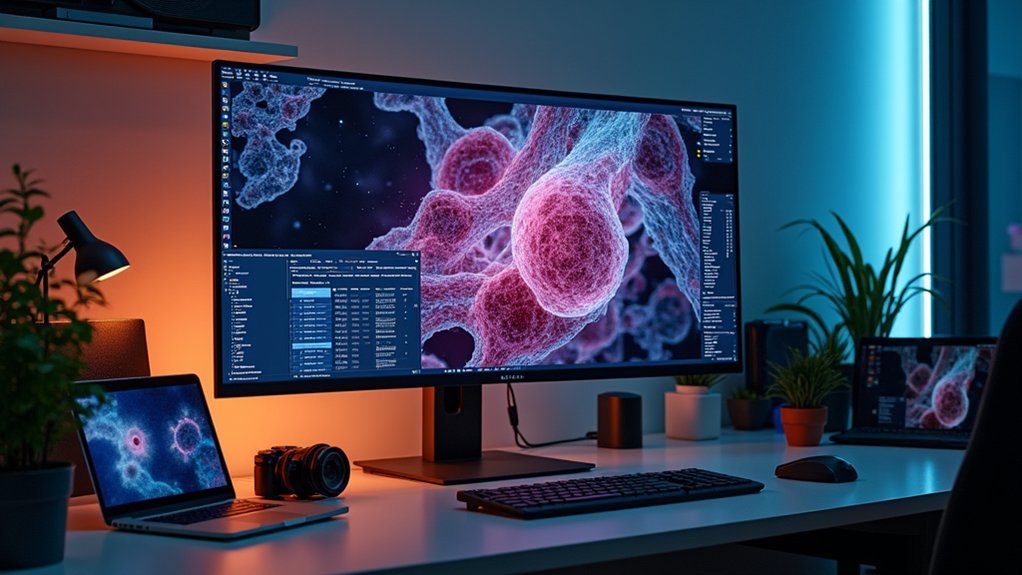



Leave a Reply